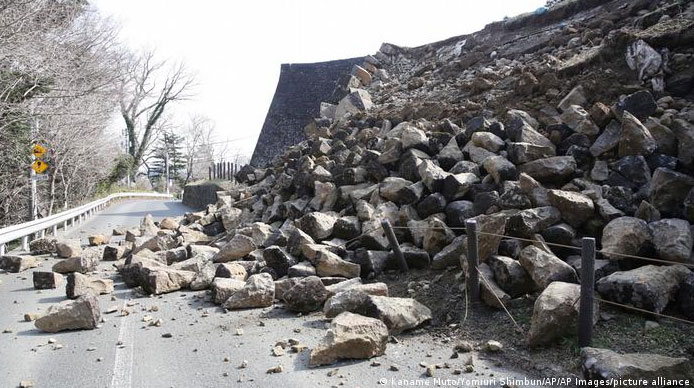The Ring of Fire Dominates the Pacific. It is a chain of at least 450 volcanoes—both active and inactive—forming a horseshoe shape that stretches approximately 40,000 kilometers.
About 90% of earthquakes occur within the Ring of Fire. This means that the lives of people in Indonesia, the Philippines, Malaysia, Japan, Australia, New Zealand, and Papua New Guinea are almost constantly under threat. Additionally, there are other island nations such as the Solomon Islands, Fiji, and many other countries in Melanesia, Micronesia, and Polynesia.

A 7.3 magnitude earthquake devastates Fukushima Prefecture, Japan – (Photo: AP)
Volcanoes form due to the collision of tectonic plates. These plates are constantly moving over a layer of partially solid and partially molten rock known as the Earth’s mantle.
When plates collide or move apart, the Earth literally shifts, according to DW.
The Pacific Ring of Fire is a direct consequence of tectonic activity and the movement and collision of Earth’s crustal plates. This area surrounds the Philippine Sea Plate, the Pacific Plate, the Juan de Fuca Plate, the Cocos Plate, and the Nazca Plate.
Many volcanoes in the Ring of Fire are formed through subduction processes. Most of the planet’s subduction zones are located within the Ring of Fire.
Subduction occurs when tectonic plates shift, and one plate is pushed beneath another. This movement of the ocean floor creates “mineral transformations”, leading to the melting and solidification of magma, and ultimately the formation of volcanoes.
If the upper plate is oceanic, it can create a chain of volcanic islands such as the Marianas. This is also where we find the deepest trenches on Earth and the deepest earthquakes.
According to the United States Geological Survey, the worst earthquake in the Ring of Fire and the world occurred in Chile on May 22, 1960. It was a 9.5 magnitude earthquake.
This was followed by the great Alaska earthquake in 1964 (9.2 magnitude); the North Sumatra earthquake—also known as the Indian Ocean tsunami—on December 26, 2004 (9.1 magnitude); and the offshore earthquake off the eastern coast of Honshu, Japan, on March 11, 2011 (9.0 magnitude), which led to a tsunami and ultimately a nuclear disaster in Fukushima.
All of these earthquakes occurred within the Ring of Fire.
Despite understanding the tectonic activity that creates volcanoes, scientists are unable to predict earthquakes in the Ring of Fire.
Currently, the geology of the Pacific Ring of Fire is under continuous stress.
Scientists warn that residents living around the Ring of Fire should be aware of the dangers. People can live further inland, build safer homes that can withstand earthquakes, and countries should improve early warning systems both at sea and on land to minimize risks to life.


















































